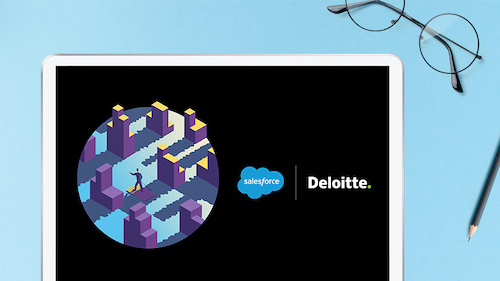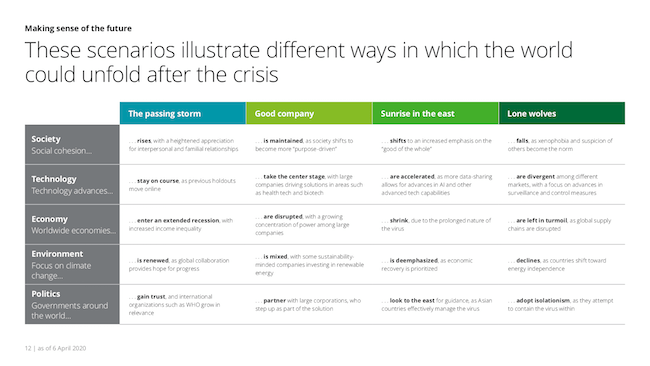Since the advent of the COVID-19 pandemic, life has changed dramatically for individuals and businesses all over the world. Experienced scenario planners, such as Peter Schwartz, are trained in the science of scenario planning- thinking about the unthinkable in a structured, balanced, careful way.
Scenario planning vs speculating. What’s the difference?
Unlike speculation, scenario planning is a structured way of thinking about and anticipating an unknown future, enabling preparation: the sort of things companies like Salesforce and Deloitte have been doing for years to help customers think about business continuity in a wide range of unlikely scenarios.
Any good company spends time thinking about how they would maintain business as much as possible in a wide variety of scenarios. In early April, Peter got together (virtually!) with Deloitte’s Andrew Blau, to discuss a variety of hypotheses of what life could be like, and how it could have changed as a result of the global health crisis. This blog explores those hypotheses. You can read the full report here.
Before we get started, as you read through each scenario, take into account:
If this was to be accurate, what previous expectations do you need to rethink?
What could be accelerated?
What would consumers value in this new world? Does it vary across geographies or demographics?
What would be the biggest threat to your business in this situation?
What new providers, ecosystems and companies might emerge in this scenario? Which would be most well positioned to succeed?
What capabilities, assets or relationships would be most important if this scenario were to come true?
Ok, so let’s dive into each of the scenarios planned by Peter and Andrew.
1. The passing storm
In this scenario, the pandemic is managed by effective responses from governments to contain the virus. It’s not without lasting repercussions, particularly (and disproportionately) affecting small businesses and lower income communities. In this scenario, society responds positively, with a heightened appreciation for interpersonal, family and neighbourly relationships.
Politics gains trust, as a result of successful virus containment measures and the rise in visibility of global organisations and medical bodies such as the World Health Organisation. There’s a renewed interest in environmental concern, and technology stays relatively on track as a result of home working. The economy likely enters an extended recession. Recovery is initially slow, but as consumer confidence grows, the economy begins to recover.
2. In Good Company
In this scenario, the COVID-19 pandemic persists past original projections, and governments struggle to handle it alone. A surge of public-private partnerships emerge as companies begin to step up as part of the solution. In this scenario, we see a greater shift towards corporate responsibility, with a greater emphasis on supporting workers and communities.
In this scenario, the tech backlash is reversed, and people become used to telecommuting for the long haul. People take responsibility for their health and security into their own hands, with a surge in AI and wearables. There’s a huge shift in the balance of power: governments lose trust, bigger companies become more resilient, and smaller companies more easily acquired. On the positive side, there is a huge surge in innovation to cope with the new normal.
3. Sunrise in the East
In this scenario, China and East Asian countries manage the pandemic more effectively, and do not see the lasting effects seen in the West- and East Asian countries take the lead on the World stage. This scenario has some fascinating societal implications: an increased acceptance of surveillance and an emphasis on ‘Eastern’ values such as the public good and shared sacrifice. This scenario results in an overall decrease in the perceived importance of climate change, and an increase in social levelling.
4. Lone Wolves
This scenario is considering the crisis to become more prolonged, and in waves, than anyone had prepared for. As a result, countries become more paranoid against the ‘invisible enemy’, and become isolationist in the name of domestic safety. This scenario results in a big surge in government surveillance to reduce the spread of the virus, as strict measures such as mandatory distancing and screening checks are implemented. Larger countries inject huge sums of money into becoming self-sustained, and withdraw from global environmental initiatives to focus on their own security.
Remember- each one of these scenarios suggests a range of possible outcomes, and generally, it’s too early to say. However, resilient leaders are thinking ahead about what the future may hold.
Again, check out the full report for much more information on each scenario.
This article is part of our Leading Through Change initiative, providing thought leadership, tips, and resources to help business leaders reopen businesses safely after COVID-19 closures.
Click image to view full presentation
The PDF includes many more details on how these four scenarios impact society, technology, environment, economy, and politics.
“These are efforts to spark new ideas about the future...if they don’t challenge your expectations, they are not doing their jobs.”
The study leaves leaders with key questions to ask after digesting the scenarios:
Which of your previous expectations need to be rethought?
What might consumers value differently in these worlds?
What are the biggest threats to your current business in these worlds?
What new providers, models, business models, and ecosystems might emerge, and who will be well-positioned?
What capabilities, relationships, and assets are most important in these worlds?
Ultimately, those who can play out the implications of each of these scenarios for their business will put themselves in the mindset of adapting and thriving versus merely recovering or surviving — a positive outcome regardless of which scenario the future most closely resembles.
If you’re looking for more resources, check out work.com: tools and support to help companies of any size navigate this time.





